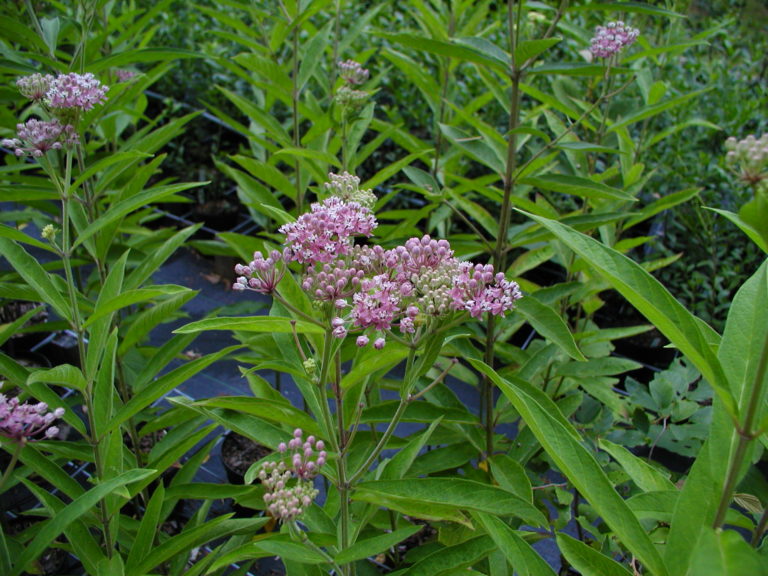The Pink Swamp Milkweed, being a milkweed, is important support for the Monarch butterflies But it is also a stunning perennial wildlfower and therefore deserving of a place in the perennial border. Even though it is found in wet meadows and swamp margins, it is also happy in a well drained upland garden soil in full or mostly full sun. It has a tap root and multiple stems which grow four to five feet high each season. Leaves are tapering and willow-like, and its pink, upright, fragrant flowers occur in somewhat flat umbels at the top of the stems in June-August. Like other milkweeds, it has a white, milky exudate from cut stems, and pods releasing seeds with silky, fluffy tails. In addition to serving as a food source for the Monarch larvae, the flowers provide a nectar source for adult butterflies of many types, and for bees as well. It is reported to occur in most of our states excepting the West coast, and in NC it is found mostly in mountain and upper piedmont counties.
NURSERY HOURS
Wednesday: 10-4 Thursday: 10-6 Friday-Saturday: 10-4 Sunday: 12-4
Asclepias incarnata

Key Info
Scientific Name: Asclepias incarnata L.
Common Names: Swamp Milkweed, Pink Milkweed
Family Names: Apocynaceae (Dogbane Family)
Plant Type: Herbaceous perennial
Flower Color: Pink/rose
Additional Info
Habit: Upright, clump-forming perennial
Height: 3' to 5'
Spread: 1' to 2'
Soil Conditions: Average to wet; will tolerate clay; pH neutral to slightly acid.
Leaves: Opposite, simple, lance-shaped leaves 4-5 inches long; fall color not remarkable.
Flowers (or reproductive structures: Fragrant, usually in shades of pink (rarely white), in terminal umbels of many small, intricate flowers with five petals; the umbels tend to be flattened.
Fruit: In fall, flowers have matured into erect, dehiscent brownish-red seed pods. These split open to release dry, flattened seeds attached to silken tails for wind transport.
Natural Distribution: Wet meadows, prairies, stream banks, swamps
USDA Hardiness Zone: 3 to 9
USDA Wetland Indicator Status in NC: OBL
Pollination: Bees, butterflies, other insects
Wildlife Connections: Swamp Milkweed attracts hummingbirds and large numbers of butterflies, native bees, bumble bees, honey bees, and beneficial insects for nectar; and is a larval host for the Monarch and Queen butterflies.
Propagation: By seed or division in spring.
